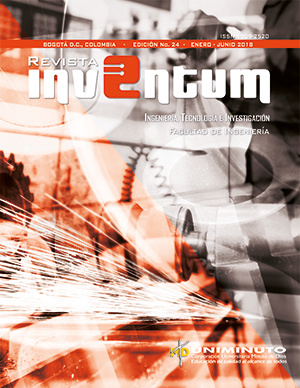Políticas de inventario para demandas con tendencia y aleatoriedad. Caso comercializadora de lubricantes
Barra lateral del artículo
Cómo citar
Altmetrics
Detalles del artículo
Se solicita a los autores que diligencien el documento de cesión de derechos de autor sobre el artículo, para que sea posible su edición, publicación y distribución en cualquier medio y modalidad: medios electrónicos, CD ROM, impresos o cualquier otra forma, con fines exclusivamente científicos, educativos y culturales
- La obra pertenece a UNIMINUTO.
- Dada la naturaleza de UNIMINUTO como Institución de Educación Superior, con un modelo universitario innovador para ofrecer Educación de alta calidad, de fácil acceso, integral y flexible; para formar profesionales altamente competentes, éticamente responsables y líderes de procesos de transformación social, EL CEDENTE ha decidido ceder los derechos patrimoniales de su OBRA, que adelante se detalla para que sea explotado por ésta
- El querer de EL CEDENTE es ceder a título gratuito los derechos patrimoniales de la OBRA a UNIMINUTO con fines académicos.
Contenido principal del artículo
Resumen
En la actualidad los inventarios son considerados como desperdicios que, debido a que no generan valor agregado, deben ser reducidos o eliminados. Sin embargo, esta reducción de inventarios no debe llevar a una disminución del nivel de servicio al cliente o generación de déficit. Considerando esto, en el presente artículo se proponen políticas de inventario que buscan mantener un nivel previamente definido de servicio al cliente con el menor costo de gestión de inventario. El trabajo se aplica en una compañía comercializadora de lubricantes cuya demanda presenta una tendencia creciente y está sujeta a aleatoriedad. Se define el modelo de pronóstico
que más se ajusta al comportamiento de la demanda, y se comprueba estadísticamente que el error del mismo se ajusta a una distribución normal con media igual a cero. Las definiciones de las políticas se basan en la combinación de técnicas heurísticas para demandas no homogéneas, como Silver Meal y Wagner-Whitin, para definir los periodos de pedido y modelos para demandas estocásticas, como los modelos de revisión periódica, para sistemas de inventarios multiproducto, en los cuales, por medio de la función de densidad de probabilidad de los errores del pronóstico, se define el stock de seguridad de cada periodo. Aplicando las técnicas previamente
mencionadas se logra obtener una política en la cual el tiempo entre periodos es variable al igual que la cantidad, lo cual no se hubiese podido obtener por medio del uso de técnicas de revisión periódica. Así se demuestra que la definición de políticas de inventario en sistemas reales requiere de la integración y adaptación de diferentes modelos de inventario para lograr ser eficientes.
Referencias
R. Ballou, Logística: Administración de la cadena de suministro. México: Pearson Educación, 2004.
Departamento Nacional de Planeación, Encuesta Nacional de Logística: Resultados Nacionales 2015. Bogotá D.C., 2015.
J. C. Hernández & A. Vizán, Lean manufacturing: Conceptos, técnicas e implantación. Madrid: EOI Escuela de Organizaciòn Industrial, 2013.
J. Venugopalan et al., “Analysis of decision models in supply chain management”, Procedia Engineering, no. 97, pp. 2259 – 2268, 2014.
C. H. Glock, “The joint economic lot size problem: A review”, International Journal of Production Economics, vol. 135, no. 2, pp. 671– 686, 2012.
F. Moshrefi, “An integrated vendor-buyer inventory model with partial backordering”, Journal of Manufacturing Technology Management, vol. 23, no. 7, pp. 869–884, 2012.
A. S. Eruguz, “A review of the Guaranteed-Service Model for multi-echelon inventory systems”, In IFAC Proceedings, no. 14, pp. 1439- 1444, 2012.
Y. Ghiami, “A two-echelon inventory model for a deteriorating item with stock-dependent demand, partial backlogging and capacity constraints”, European Journal of Operational Research, vol. 231, no. 3, pp. 587–597, 2013.
A. A. Taleizadeh et al., “Revisiting a fuzzy rough economic order quantity model for deteriorating items considering quantity discount and prepayment”, Mathematical and Computer Modelling, vol. 57, no. 5–6, pp. 1466–1479, 2013.
S. M. Samak-Kulkarni & N. R. Rajhans, “Determination of Optimum Inventory Model for Minimizing Total Inventory Cost”, Procedia Engineering, no. 51, pp. 803–809, 2013.
A. Tanweer et al., “An Optimization Model for Mitigating Bullwhip-effect in a Two-echelon Supply Chain”, Procedia - Social and Behavioral Sciences, no. 138, pp. 289–297, 2014.
L. E. Cárdenas-Barrón & S. S. Sana, “Multi-item EOQ inventory model in a two-layer supply chain while demand varies with promotional effort”, Applied Mathematical Modelling, vol. 39, no. 21, pp. 6725–6737, 2015.
J. Sadeghi, “A multi-item integrated inventory model with different replenishment frequencies of retailers in a two-echelon supply chain management: a tuned-parameters hybrid meta-heuristic”, Opsearch, vol. 52, no. 4, pp. 631–649, 2015.
M. A. Bushuev, “A review of inventory lot sizing review papers”, Management Research Review, vol. 38, no. 3, pp. 283–298, 2015.
D. Sipper, Planeación y control de la producción. México, D.F: Mc Graw Hill, 1998.





